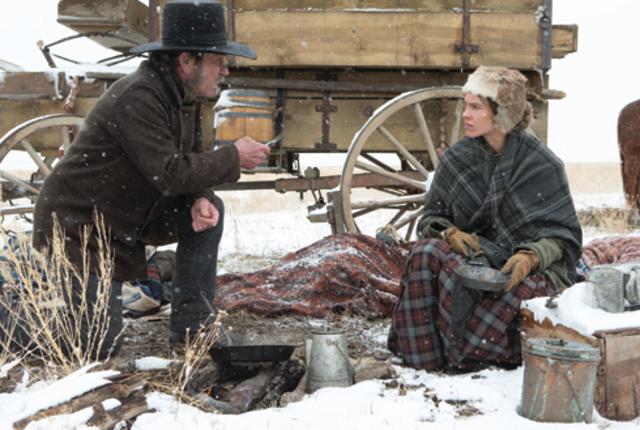A high-wattage NM–based team produces a wild and gritty Western.
The Homesman is the latest unconventional Western to have been hatched in New Mexico. Starring Tommy Lee Jones and Hilary Swank, it debuted to positive reviews at the Cannes Film Festival in May, and it opens nationally this month.
The project sprang to life in Santa Fe, during a lunch meeting at SantaCafé. Taos resident and film producer Michael Fitzgerald asked Santa Fe habitué and lauded actor/playwright Sam Shepard if he knew of a good Western story that was suited to Tommy Lee Jones. In 2005, Fitzgerald had made The Three Burials of Melquiades Estrada with Jones, and he was eager to work with him again. Shepard suggested Glendon Swarthout’s novel The Homesman, the tale of a spinster schoolteacher and a dodgy claim jumper who team up against the odds to transport three mentally unhinged female settlers from Nebraska to parts east. Shepard, also a screenwriter partial to Westerns, had failed to wrest rights to the story from Sony Pictures, which had owned them ever since Paul Newman tried to make it in 1988. “Sam thought it would be right up Tommy’s alley,” says Fitzgerald, and he concurred as soon as he read the book.
Jones was at work with Meryl Streep on the movie Hope Springs when he received word that Sony had consented to sell the rights to The Homesman. He and screenwriters Kieran Fitzgerald— Michael’s son, who was hailed by Variety as one of “Ten Screenwriters to Watch” in 2013—and Wesley Oliver, Jones’ former lawyer and current writing partner, started work on the screenplay at Jones’ home in Tesuque.
Three years after Fitzgerald and Shepard’s fortuitous lunch, The Homesman will open on the big screen. Rather than romanticizing the macho spirit of the Wild West, the movie tells the stories of three women who cracked from the strains of pioneer life. Swank, who won Best Actress Oscars for Boys Don’t Cry (1999) and Million Dollar Baby (2004), plays Mary Bee Cuddy, the spinster who signs up for a job usually undertaken by men: transporting women suffering from nervous breakdowns back to Iowa. But when the task proves too daunting, she enlists the help of Jones’ character. The cast includes Grace Gummer, John Lithgow, James Spader, and Meryl Streep.
Though the novel is set in Nebraska, the movie was mostly made in New Mexico over 44 days in the spring of 2013. “The prairie land in northeast New Mexico looks just like Nebraska in the late 19th century,” claims Fitzgerald, who says he joked with Alexander Payne, the director of Oscar-nominated film Nebraska, that “our Nebraska looks more like Nebraska than his.” The filmmakers shot with film rather than digital cameras in order to capture the feel of the mid-19th-century story.
Between 40 and 100 crew members worked on the 75,000-acre Buena Vista Ranch, near Las Vegas, before moving on to Los Luceros, the former Mary Cabot Wheelwright property in Alcalde that Robert Redford bought in 2011 to give to the state for filmmaking training purposes. Los Luceros, on the Río Grande, provided the location for some of the film’s river scenes.
Kieran Fitzgerald, who frequently stays in his family’s historic adobe house in Taos, says that filmmaking in New Mexico capitalizes on the same natural elements, including the light, that attract painters and photographers to New Mexico. His producer father appreciates the favorable terms that are offered to film companies—and being close to home. The Homesman, his 15th movie, is the first he has made here. He and other top crew members often stayed at the Plaza Hotel in Las Vegas, where the Coen brothers shot some of No Country for Old Men in 2007.
Sometimes, however, the weather mirrored the mental states of the film’s unstable female characters. Flash snowstorms, howling 40-mile-per-hour winds, and sudden temperature plunges challenged the filmmakers. In hindsight, screenwriter Fitzgerald found that the weather “kept things riveting and raw, and that was important to the story. We capitalized on that.”
Cherie Burns is the author of Searching for Beauty: The Life of Millicent Rogers, the American Heiress Who Taught the World About Style (St. Martin’s Press).


